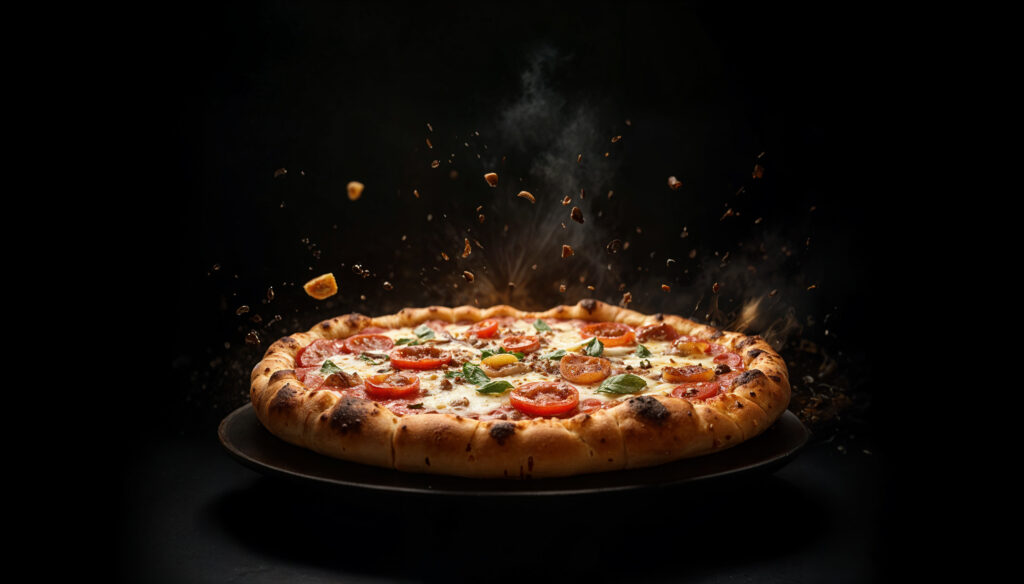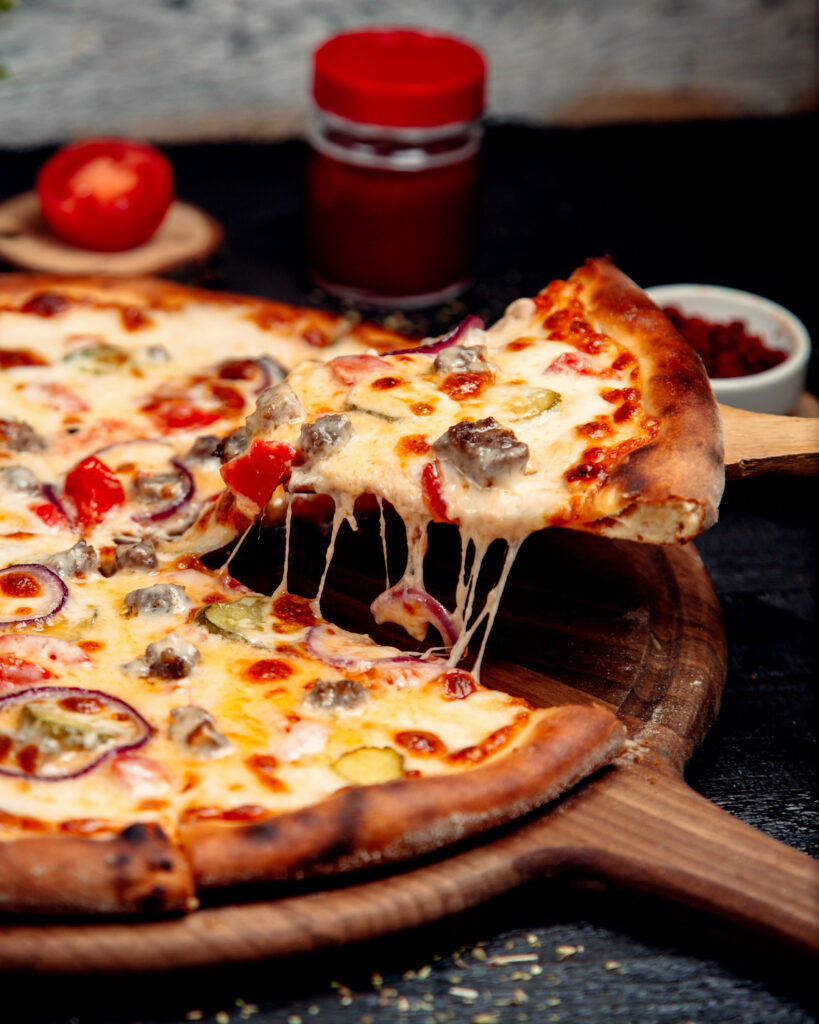By Shammas / April 27, 2025
Perfect Pizza —whether you’re grabbing a quick slice, crafting a gourmet masterpiece at home, or enjoying the perfect pie from your favorite pizzeria—holds a special place in our hearts. It’s the kind of food that crosses all borders, brings together families, and transcends generations. It’s a universal language of comfort, and over the centuries, it has evolved from a humble flatbread to an international icon.
Today, perfect pizza is a blank canvas for endless culinary creativity—toppings, crusts, sauces, and styles from around the world. But how did we get here? From ancient flatbreads to globally loved pies, the journey to the perfect pizza is rich with history, innovation, and culture. In this blog, we’ll explore how pizza evolved into the beloved dish it is today—diverse, delicious, and endlessly inspiring.
The Ancient Beginnings: Flatbreads and Fire
Before perfect pizza became the globally recognized dish we devour today, it had humble beginnings. The origins of pizza can be traced all the way back to ancient civilizations. The concept of flatbreads topped with various ingredients is something that transcends cultures and goes as far back as 3000 BCE in places like Egypt, Greece, and even the ancient Roman Empire. These early flatbreads were often baked on stones and were topped with various items like olive oil, honey, cheese, and herbs. However, they lacked the iconic combination of tomato sauce and cheese that we associate with modern pizza today.
It wasn’t until the late 18th century in Naples, Italy, that the pizza we recognize today truly began to take shape. Street vendors began offering these flatbreads topped with tomatoes, a relatively new arrival to Europe after the vegetable was brought back from the Americas. The tomato, once thought to be poisonous, was finally embraced in Italian cuisine, and the first versions of pizza began to appear on the streets of Naples, setting the stage for the evolution of the perfect pizza we enjoy today.
Pizza’s Italian Renaissance: Naples and the Birth of the Modern Pie
The true turning point in the journey toward the perfect pizza came in the late 19th century, right in the vibrant heart of Naples, Italy. By this time, pizza had become more than just a street snack—it was a vital part of the working-class diet. Vendors pushed carts through crowded alleys, selling hot, rustic pies topped with simple yet flavorful ingredients like tomatoes, garlic, oil, cheese, and herbs. Affordable, portable, and deeply satisfying, these pizzas were crafted for the busy, hard-working people of Naples who needed nourishment that was quick, filling, and delicious.
Then came a moment that would forever change the story of pizza. In 1889, Queen Margherita of Savoy visited Naples with King Umberto I, and a local pizzaiolo named Raffaele Esposito was summoned to prepare a dish in her honor. Wanting to create something that embodied national pride, Esposito crafted a pizza using red tomatoes, white mozzarella, and green basil—mirroring the colors of the Italian flag. The queen was delighted by its simplicity and flavor, and Esposito named the creation Pizza Margherita in her honor.
This humble yet symbolic pizza was a turning point. For the first time, pizza transcended its image as food for the poor and became a dish fit for royalty. The Margherita pizza perfectly embodied the emerging principles of the perfect pizza: balance, freshness, simplicity, and national identity. It laid the groundwork for modern pizza as we know it, introducing the world to the concept of a pie that could be elegant, artisanal, and universally beloved.
From that royal table in Naples, the influence of Pizza Margherita began to spread beyond Italy’s borders. It sparked a culinary revolution that elevated pizza from street fare to a celebrated art form. This wasn’t just about adding toppings to flatbread anymore—it was about crafting a pizza experience that captured hearts, honored tradition, and inspired innovation.
And thus, the foundation was set for what would become one of the most cherished and evolving dishes in the world—the perfect pizza.

The Italian-American Fusion: Pizza’s Journey Across the Ocean
As pizza was perfected in Italy, it made its way across the Atlantic, gaining popularity in the United States thanks to Italian immigrants. Cities like New York and Chicago became hubs for pizza, with pizzerias offering Neapolitan-style pies. However, the American palate soon demanded more variety, leading to distinct regional styles. In New York, the thin, foldable slices with a crispy yet chewy crust became iconic, while Chicago introduced the deep-dish pizza, with its thick, buttery crust, layers of cheese, and rich tomato sauce. The history of pizza in America is a blend of Italian tradition and American innovation.
The perfect pizza in America evolved as a fusion of Italian tradition and American innovation. By the mid-20th century, the flavor-packed pies of the United States had become a beloved version of pizza. The addition of unique toppings, larger portions, and cheese-laden crusts turned pizza into an iconic American food. The influence of these styles reached worldwide, and the American pizza culture continues to inspire pizzerias around the globe, proving that the perfect pizza is a canvas that can be reinterpreted in countless ways. The history of pizza in the U.S. showcases how it became an integral part of American cuisine.
While the perfect pizza was being perfected in Italy, it took a transatlantic journey to truly take off in the United States. Italian immigrants, bringing with them their rich pizza traditions, began to introduce pizza to the American public in the early 20th century. However, the American appetite for pizza soon demanded more variety, leading to the creation of pizza styles that were distinctly American. In New York, the thin, foldable slices with a crispy yet chewy crust became the gold standard, while Chicago embraced the deep-dish pizza, with its thick, buttery crust, layers of cheese, and hearty tomato sauce. The history of pizza in America is a tale of adaptation and creativity.
The perfect pizza in America evolved as a fusion of Italian tradition and American innovation. By the mid-20th century, the flavor-packed pies of the United States had become a beloved version of pizza. The addition of unique toppings, larger portions, and cheese-laden crusts turned pizza into an iconic American food. The influence of these styles reached worldwide, and the American pizza culture continues to inspire pizzerias around the globe, proving that the perfect pizza is a canvas that can be reinterpreted in countless ways. The history of pizza in America reflects its transformation from an immigrant dish to a staple of the American diet.
With the rise of national pizza chains like Domino’s, Pizza Hut, and Papa John’s in the 1960s and 1970s, pizza became more accessible than ever. Delivery pizza became a staple of American life, offering convenience and affordability while still retaining the essence of pizza as a comfort food. These chains adapted the perfect pizza for a fast-paced lifestyle, creating pies that could be mass-produced, quickly delivered, and enjoyed at home. As a result, pizza became ingrained in American culture, with everyone—from busy professionals to families—celebrating pizza night as a tradition. The history of pizza in this era shows how it became a cultural phenomenon.
As pizza continued to evolve, regional variations emerged across the U.S., each putting its own twist on the beloved dish. Whether it’s the sweet and tangy barbecue chicken pizza of the West Coast or the unique white pizza of New England, every corner of the country put its own mark on the perfect pizza. Today, pizza remains an ever-evolving art form, balancing tradition with innovation and always striving for that perfect bite. The history of pizza continues to unfold as new trends and flavors shape the future of this beloved dish.
4o mini
The Italian-American Connection: The Birth of the Global Pizza
While perfect pizza was growing in popularity throughout Italy, it wasn’t until the early 20th century that pizza made its way across the Atlantic to the United States. In fact, it was Italian immigrants arriving in cities like New York and Chicago who first introduced pizza to the American public.
In New York, pizza quickly gained popularity, especially among Italian-Americans who sought a taste of home. Pizzerias started popping up, and the classic Neapolitan pizza, with its thin, charred crust and simple toppings, became a staple in these new restaurants. However, as pizza began to gain traction in the U.S., something changed. The American palate demanded more—more cheese, more toppings, and bigger portions.
By the 1940s and 1950s, pizza was starting to look very different from its Italian counterpart. American pizza makers began experimenting with thicker crusts, more cheese, and different types of toppings. Chicago-style deep-dish pizza, with its thick, buttery crust and rich layers of cheese and sauce, became a sensation. Meanwhile, New York-style pizza became iconic for its large, foldable slices, crispy yet chewy crust, and generous layer of gooey cheese.
The perfect pizza landscape in the U.S. was no longer just about thin crusts and simple toppings. It was evolving into something that reflected the diverse tastes and creativity of the American people. Pizza was no longer a foreign import—it was becoming Americanized, and everyone, from coast to coast, was embracing it. This marks a significant chapter in the ongoing evolution of the perfect pizza, and it laid the groundwork for the diverse pizza varieties we enjoy today.

The Rise of Fast Food Pizza: Convenience Meets Quality
As perfect pizza became an increasingly popular choice in American homes, fast food chains like Domino’s, Pizza Hut, and Papa John’s began making their mark in the 1960s and 1970s. These chains revolutionized the way people thought about pizza, transforming it into a convenient, affordable, and fast meal option that could be delivered straight to your door. No longer confined to pizzerias or reserved for special occasions, perfect pizza became an everyday indulgence—accessible to everyone, anytime.
The rise of delivery pizza was a game-changer. Suddenly, pizza was no longer a meal to be eaten out at a restaurant—it could be enjoyed at home, in front of the TV, during parties, or even at work. These pizza chains streamlined the entire production process, crafting pizzas that could be quickly prepared, efficiently baked, and delivered within minutes. With innovations like stuffed crusts, thick pan pizzas, and an ever-expanding range of toppings, they helped solidify pizza’s place as a national staple.
However, this era of rapid expansion came at a cost. As convenience became the focal point, many food lovers and culinary purists began to lament the loss of the artistry and authenticity that once defined traditional pizza-making. Mass production often meant sacrificing flavor, freshness, and quality for speed and uniformity. While millions enjoyed these quick-service pies, others longed for the soul, texture, and balance that define the perfect pizza.
Yet, even during this time of standardization, a quiet resistance was brewing. Passionate pizza artisans, inspired by tradition and quality, began to reimagine what pizza could be. They believed the perfect pizza deserved more than fast production lines and pre-made ingredients. This marked the beginning of a new chapter in the evolution of perfect pizza—one that would seek to merge the convenience of modern delivery with the craftsmanship of old-world techniques.
This pivotal moment in pizza history paved the way for a culinary renaissance. Chefs, bakers, and pizza enthusiasts across the country began focusing on sourcing premium ingredients, developing long-fermented dough, and reviving wood-fired ovens—all in pursuit of the ultimate pizza experience. The revolution of perfect pizza was just getting started. Check out our other Blogs.

The Pizza Renaissance: Back to the Basics
In the 1990s and 2000s, a remarkable shift occurred in the world of pizza—an era that many now celebrate as the dawn of the artisanal pizza renaissance. This was more than just a culinary trend; it was a full-fledged movement that redefined what the perfect pizza could be. After decades of fast-food domination, conveyor belts, and frozen crusts, a new generation of chefs, bakers, and passionate home cooks began to turn back the clock. They dug deep into the origins of pizza-making, uncovering the beauty of simplicity, quality, and time-honored technique—all in pursuit of the perfect pizza.
This period was marked by a collective rediscovery of tradition. Pizzerias that had once prided themselves on efficiency and mass production began to focus instead on authenticity and craftsmanship—core values in the creation of the perfect pizza. Chefs installed wood-fired ovens modeled after the brick domes of Naples. Dough was no longer an afterthought—it became a central obsession, slow-fermented over several days to develop complex flavors and textures. The crust, once just a base, now stood tall as the defining feature of the perfect pizza, earning respect in its own right.
A huge part of this movement was driven by the growing popularity of the farm-to-table philosophy, which brought a new level of integrity and intention to every ingredient. This emphasis on sustainability and freshness was essential in building the perfect pizza—one that told a story with every bite. Heirloom tomatoes, hand-pulled mozzarella, and herbs picked just hours before baking added layers of flavor and meaning. In this era, the perfect pizza was not only about taste but also about transparency, ethics, and origin.
This culinary renaissance also opened the door for bold, gourmet creativity, stretching the imagination of what could sit atop the perfect pizza. Classic toppings were joined by luxurious and unexpected additions: drizzles of truffle oil, sweet and savory fig jams, peppery arugula, hot honey, and the velvety richness of burrata. Each combination was carefully considered, layered with intention to deliver a symphony of flavors. The perfect pizza became a celebration of contrast—comforting yet adventurous, rustic yet refined.
But perhaps the most transformative element of this era wasn’t happening inside restaurants—it was unfolding online. The digital age gave birth to a global pizza classroom, where aspiring chefs and curious home bakers came together in search of their own perfect pizza. Blogs, video tutorials, and food forums democratized knowledge. Techniques were no longer guarded secrets but shared openly, turning kitchens everywhere into experimental laboratories for crust, sauce, and topping perfection.
Online communities bloomed around a shared love of pizza, with members documenting their relentless pursuit of the perfect pizza. They swapped hydration ratios, debated flour types, and showed off charred crusts with pride. The rise of terms like “cold ferment,” “high-hydration dough,” and “leopard spotting” reflected a culture obsessed with nuance. And as these enthusiasts compared their creations, the definition of the perfect pizza expanded to include not just Neapolitan or New York styles, but a tapestry of regional and international influences.
This explosion of creativity gave rise to what could only be described as a global pizza awakening. Around the world, culinary minds used their cultural perspectives to reinterpret the perfect pizza. Kimchi, Thai basil, tandoori chicken, and miso-infused sauces graced pizzas in kitchens from Seoul to San Francisco. These globally inspired innovations didn’t replace tradition—they reimagined it, proving that the perfect pizza could evolve endlessly without losing its soul.
As this movement took root, the pizzeria itself was reimagined. No longer just a quick stop for a cheap bite, it became a culinary destination. People waited patiently in long lines for a chance to taste a meticulously crafted slice, often baked in ovens that reached temperatures nearing 1,000 degrees. Critics and foodies alike evaluated every detail, from crust chew to the interplay of sauce and cheese—all in the name of discovering the perfect pizza.
What made this golden era extraordinary was its ability to honor history while welcoming innovation. The best pizza makers respected the sacred traditions of Naples, yet weren’t afraid to experiment with new techniques and ingredients. The perfect pizza was no longer a static concept—it was a living dialogue, a fusion of past wisdom and present passion. This duality made every pie personal, every slice unique, every bite a reflection of time and place.
Ultimately, the artisanal pizza renaissance of the 1990s and 2000s didn’t just change how we made pizza—it changed how we experienced it. It taught us that the perfect pizza is not defined by a single recipe or style, but by the care, intention, and creativity baked into it. Whether shaped in a tiny kitchen or a world-class pizzeria, whether topped with simplicity or decadence, the perfect pizza is a labor of love—a timeless reminder that even the most humble foods can rise to greatness. Check out our Menu.

The Future of Pizza: Innovation and Tradition
Today, the perfect pizza is more diverse and dynamic than ever. From the traditional Neapolitan pies of Naples to the bold, flavor-packed creations found in every corner of the globe, the quest for the perfect pizza continues to fuel innovation and creativity. Fusion pizzas now embrace flavors from around the world—think Korean BBQ, Indian curry, Thai peanut sauce, or Mexican street corn—each offering a unique and modern twist on the classic pie. At the same time, many pizzerias remain devoted to honoring pizza’s roots, returning to time-tested methods with expertly fermented dough, wood-fired ovens, and the finest seasonal ingredients to craft their vision of the perfect pizza.
Modern dietary preferences have also influenced what the perfect pizza looks like today. With gluten-free crusts, cauliflower bases, plant-based cheeses, and dairy-free sauces becoming more mainstream, pizza is more inclusive and customizable than ever before. These innovations prove that the perfect pizza is not a fixed recipe—it’s an evolving idea shaped by culture, preference, and imagination.
Pizza is more than just a dish—it’s a global symbol of creativity, culture, and connection. From its humble beginnings as a simple flatbread in ancient civilizations to the international culinary icon it is today, pizza has always adapted with the times while staying rooted in tradition.
So, the next time you bite into a slice of your favorite pie, pause for a moment. You’re not just enjoying crust, sauce, and cheese—you’re savoring generations of tradition, experimentation, and passion. The journey to the perfect pizza is still unfolding, and every slice is a delicious part of that ongoing story.
